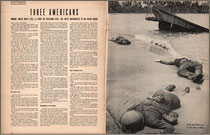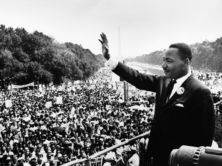
Life magazine published this photograph taken by George Strock in February 1943. Life, like all other media outlets during World War II, was required to follow U.S. government censorship for their wartime reportage. The above image, as reported by IconicPhotos blog, did not appear in Life until September 20, 1943, after government approval. The blog writes: "The photo of three dead American soldiers lying in the sand on shoreline near half sunken landing craft on Buna Beach, Papua New Guinea was now considered a war classic."
“Freedom of the Press” is not a given during wartime.
IconicPhotos, a blog that features “Famous, Infamous and Iconic Photos,” writes about the realities of media censorship during World War II. They state: “All news about the war had to pass through the Office of War Information (OWI). A ‘Code of Wartime Practices for the American Press’ was issued on Jan 15, 1942, giving strict instructions on proper handling of news.”
IconicPhotos continues, “The code was voluntarily adopted by all of the major news organizations and implemented by the more than 1,600 members of the press accredited by the armed forces during the war. The government also relied heavily on reporter’s patriotism, which ensured that in their dispatches from the front lines, they tended to accentuate the positive.”
The blog explains that the photograph above, taken by George Strock, was “the first time an image of dead American troops appeared in media during World War II without their bodies being draped, in coffins, or otherwise covered up.”
The photo was taken in Papua New Guinea, February 1943, but Life magazine, like all other media outlets during WWII, was required to wait as part of complying with U.S. government censorship for wartime reportage. The above image, as reported by IconicPhotos blog, did not appear in the pages of Life until September 20, 1943, after government approval. The approval came mainly through the efforts of OWI chief Elmer Davis, who complained to President Roosevelt that the government’s policy of showing only “reassuring” images from the war front was having the effect of making the American public complacent about the war’s duration. After Strock’s belated photograph appeared in Life, writes George H. Roeder Jr. in The Censored War: American Visual Experience During World War Two (Yale Univ. Press), “The Washington Post said it was time that the government treated Americans as adults, and the photographs ‘can help us to understand something of what has been sacrificed for the victories we have won’.”
It is notable that even today, images published by U.S. media of American war dead and injured are treated much differently than casualties from other countries. Graphic images of our enemies or people in non-Western countries are commonly found in U.S. media that would cause an uproar if the same images depicted dead or wounded Americans.







Comments Terms and Conditions